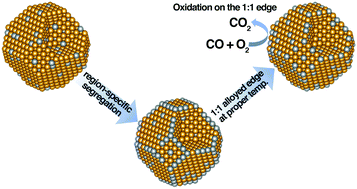当前位置:
X-MOL 学术
›
Chem. Commun.
›
论文详情
Our official English website, www.x-mol.net, welcomes your
feedback! (Note: you will need to create a separate account there.)
The region-specific segregation and catalytic activity of gold–silver nanoparticles
Chemical Communications ( IF 4.3 ) Pub Date : 2017-12-13 00:00:00 , DOI: 10.1039/c7cc07963j Xiang He 1, 2, 3, 4, 5 , Sheng-En Zhang 6, 7, 8, 9, 10 , Feng Cheng 6, 7, 8, 9, 10 , Zhao-Xu Chen 6, 7, 8, 9, 10
Chemical Communications ( IF 4.3 ) Pub Date : 2017-12-13 00:00:00 , DOI: 10.1039/c7cc07963j Xiang He 1, 2, 3, 4, 5 , Sheng-En Zhang 6, 7, 8, 9, 10 , Feng Cheng 6, 7, 8, 9, 10 , Zhao-Xu Chen 6, 7, 8, 9, 10
Affiliation

|
A coordination-dependent interatomic interaction is developed for Ag atoms and applied to simulate Au–Ag alloy nanoparticles ranging from 2.6 nm to 4.5 nm with different composition ratios at different temperatures. Using the lattice Monte Carlo method, we found that Ag segregates preferentially on the edges of nanoparticles. The region-specific segregation is revealed by our study and it indicates that depending on the size and temperature, Ag may segregate on the edges only, whereas its segregation on flat surfaces is negligible. Assuming that equimolar Au–Ag edges maximize the catalytic synergistic effect, we predicted the size and composition dependent optimal reaction temperatures for the Au–Ag catalyzed CO oxidation, which agree with the available experimental temperatures very well. Our study demonstrates that the region-specific segregation not only complements the details of surface segregation but is also very important for the utilization and tuning of faceted bimetallic nanoparticles.
中文翻译:

金银纳米粒子的区域特定分离和催化活性
针对银原子开发了依赖于配位的原子间相互作用,并将其应用于模拟在不同温度下具有不同组成比的2.6 nm至4.5 nm范围内的Au-Ag合金纳米粒子。使用格子蒙特卡罗方法,我们发现Ag优先偏析在纳米颗粒的边缘。我们的研究揭示了特定区域的偏析,表明根据大小和温度,Ag可能仅在边缘偏析,而在平面上的偏析则可忽略不计。假设等摩尔的Au-Ag边缘能最大程度地发挥催化协同作用,我们预测了Au-Ag催化的CO氧化反应的大小和成分决定的最佳反应温度,这与可用的实验温度非常吻合。
更新日期:2018-01-16
中文翻译:

金银纳米粒子的区域特定分离和催化活性
针对银原子开发了依赖于配位的原子间相互作用,并将其应用于模拟在不同温度下具有不同组成比的2.6 nm至4.5 nm范围内的Au-Ag合金纳米粒子。使用格子蒙特卡罗方法,我们发现Ag优先偏析在纳米颗粒的边缘。我们的研究揭示了特定区域的偏析,表明根据大小和温度,Ag可能仅在边缘偏析,而在平面上的偏析则可忽略不计。假设等摩尔的Au-Ag边缘能最大程度地发挥催化协同作用,我们预测了Au-Ag催化的CO氧化反应的大小和成分决定的最佳反应温度,这与可用的实验温度非常吻合。











































 京公网安备 11010802027423号
京公网安备 11010802027423号